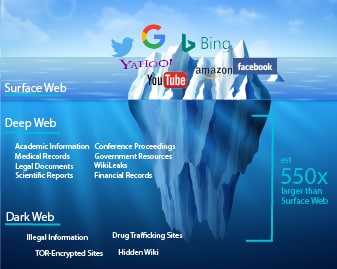Do You Need Dark Web Monitoring?
Data and information security has been a top priority of businesses for years. Firewalls, password policies, and user right limitations help control information flow in and out of your company. Digital credentials such as user names and passwords enable you and your employees to access your business systems and data as well as online services in a way that protects the business from hackers. Passwords are definitely helpful but they are hardly a fool-proof security practice in the world of cyber security. According to Verizon’s 2017 Data Breach Investigations Report, 81% of hacking-related data breaches involve the use of a weak or stolen password. When using stolen credentials, cyber criminals essentially have a digital key to the front door of your network, making all of your other security precautions worthless. These credentials are often purchased on the Dark Web, and if you aren’t monitoring your company domain your data and your client’s data could be sold to the highest bidder long before you realize there has been a data breach. In this post we will take a deep dive into the Dark Web to discuss:
- What is the Dark Web?
- Why is Dark Web Monitoring Important to Your Business?
What is the Dark Web?
Beneath the surface of the visible information accessed and indexed in Search Engines lies the Deep Web. The Deep Web is a massive sublayer of the Internet that is not indexed (and therefore hidden) in search engines such as Google, Bing, or Yahoo. Within this hidden universe lives a nefarious community called the Dark Web. Many estimate that the Dark Web is 550 times larger than the Surface Web and growing. It’s actually difficult to know for sure how big the Dark Web is. The Dark Web operates differently than the Internet we see every day, or “Surface Web.” Users on the Dark Web use secure browsers, such as Tor, that render their identity and location untraceable. This is accomplished by routing web page requests through numerous proxy servers around the globe which makes IP addresses unidentifiable. The ability to operate anonymously makes the Dark Web an ideal marketplace for stolen data and illegal activity. Experts estimate that as much as 50% of the data on the Dark Web is illegal or illicit material. In short, it is the last place you want to find your company’s sensitive data. Unfortunately, digital credentials are among the most valuable assets on the Dark Web. An article by CSO from IDG reports that login credentials to a $50,000 bank account could go for $500 while a Netflix premium account login can go for around $6. These risks are not all aimed at personal information and accounts. A 2019 study, Into the Web of Profit, by Dr. Michael McGuires at the University of Surrey shows that the number of dark web listings that could harm an enterprise has risen by 20% since 2016. This can be disastrous for your company.
Many estimate that the Dark Web is 550 times larger than the Surface Web and growing. It’s actually difficult to know for sure how big the Dark Web is. The Dark Web operates differently than the Internet we see every day, or “Surface Web.” Users on the Dark Web use secure browsers, such as Tor, that render their identity and location untraceable. This is accomplished by routing web page requests through numerous proxy servers around the globe which makes IP addresses unidentifiable. The ability to operate anonymously makes the Dark Web an ideal marketplace for stolen data and illegal activity. Experts estimate that as much as 50% of the data on the Dark Web is illegal or illicit material. In short, it is the last place you want to find your company’s sensitive data. Unfortunately, digital credentials are among the most valuable assets on the Dark Web. An article by CSO from IDG reports that login credentials to a $50,000 bank account could go for $500 while a Netflix premium account login can go for around $6. These risks are not all aimed at personal information and accounts. A 2019 study, Into the Web of Profit, by Dr. Michael McGuires at the University of Surrey shows that the number of dark web listings that could harm an enterprise has risen by 20% since 2016. This can be disastrous for your company.
Why is Dark Web Monitoring Important to Your Business?
Luckily, it is possible to scan the Dark Web and detect credential theft before cybercriminals have the opportunity to hack your system. Our monitoring solution combines human and Dark Web intelligence with search capability to identify, analyze, and proactively monitor your organization’s compromised or stolen data. We can search for stolen email addresses, passwords, and other confidential data in:
- Private Sites
- Botnets
- Peer-to-Peer Networks
- Internet Relay Chat (IRC) Channels
- Black Market Websites
- Social Media
- Hidden Chatrooms
Montra’s Dark Web services monitor your data and notify you immediately when sensitive information is found on the Dark Web. Then, our team will remediate the situation before any identity theft, data breaches, or other crimes occur. In addition to Dark Web Monitoring, Montra provides employee training, phishing simulation, and Identity Theft protection. This insures your business’ sensitive data is secure. Interested in learning more about our Dark Web Security Services? Download our datasheet
